LST2LBA: Corporate Law Assignment - Semester 2 2019
VerifiedAdded on 2022/10/14
|9
|1993
|11
Homework Assignment
AI Summary
This document presents a comprehensive solution to a corporate law assignment, addressing key legal concepts and providing detailed case analyses. The assignment explores two distinct scenarios: the first involves a breach of contract by a company director (Motorbikes Pty Ltd) and the second focuses on a contract dispute regarding the sale of a cake shop (Cakes Pty Ltd). The solution delves into relevant legal principles, including contract formation, breach of contract under the Corporations Act 2001 (Cth), and the implications of signing contracts on behalf of a company. The analysis incorporates legal precedents and case law, such as AGC (Advances) Ltd v McWhirter, Crown v Clarke, and Balfour v Balfour, to support the arguments. The assignment highlights the significance of legal capacity, intent, and the enforceability of contracts, providing a thorough understanding of the legal issues involved in each case, and ultimately arriving at conclusions regarding the contractual obligations and potential liabilities of the parties involved.
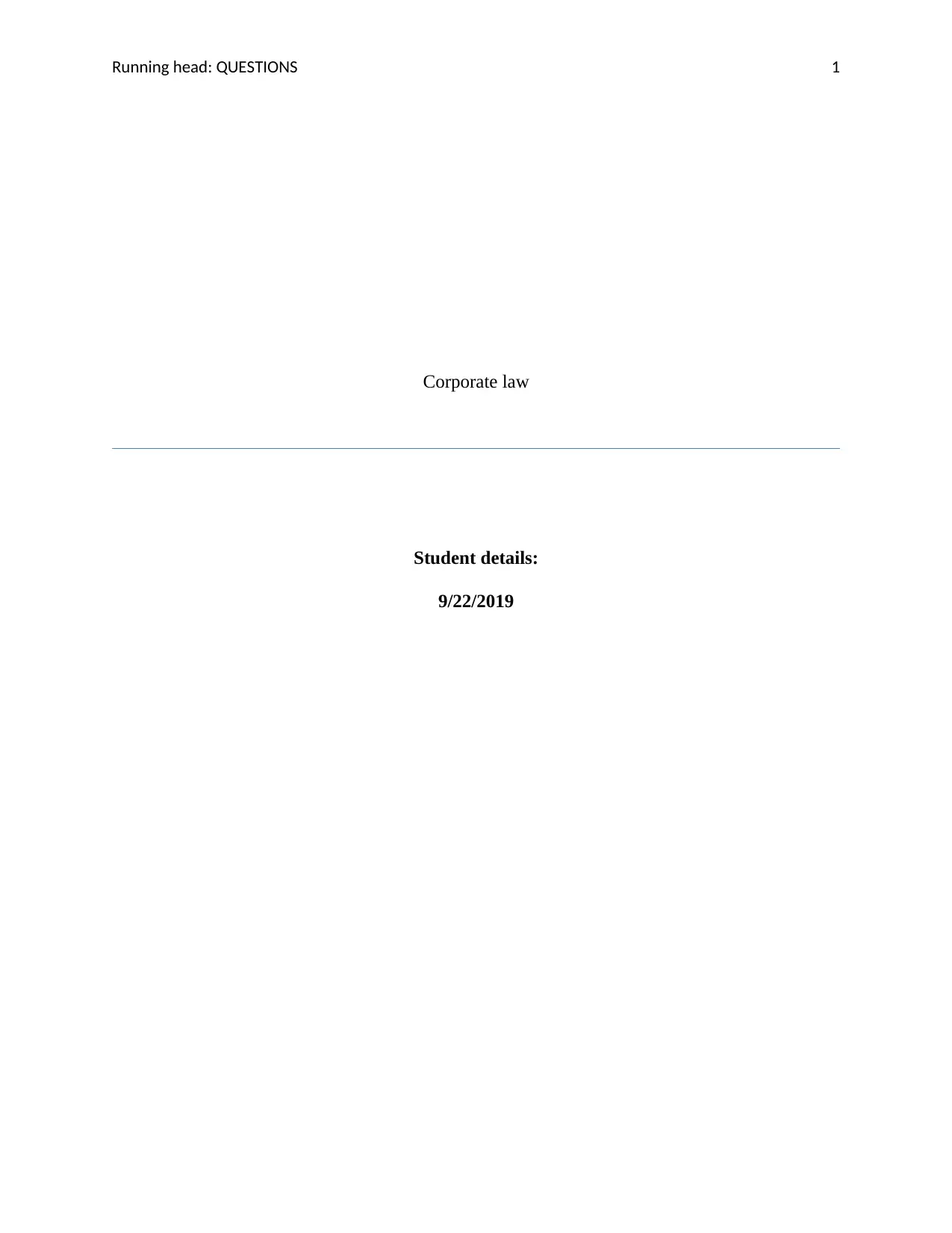
Running head: QUESTIONS 1
Corporate law
Student details:
9/22/2019
Corporate law
Student details:
9/22/2019
Paraphrase This Document
Need a fresh take? Get an instant paraphrase of this document with our AI Paraphraser
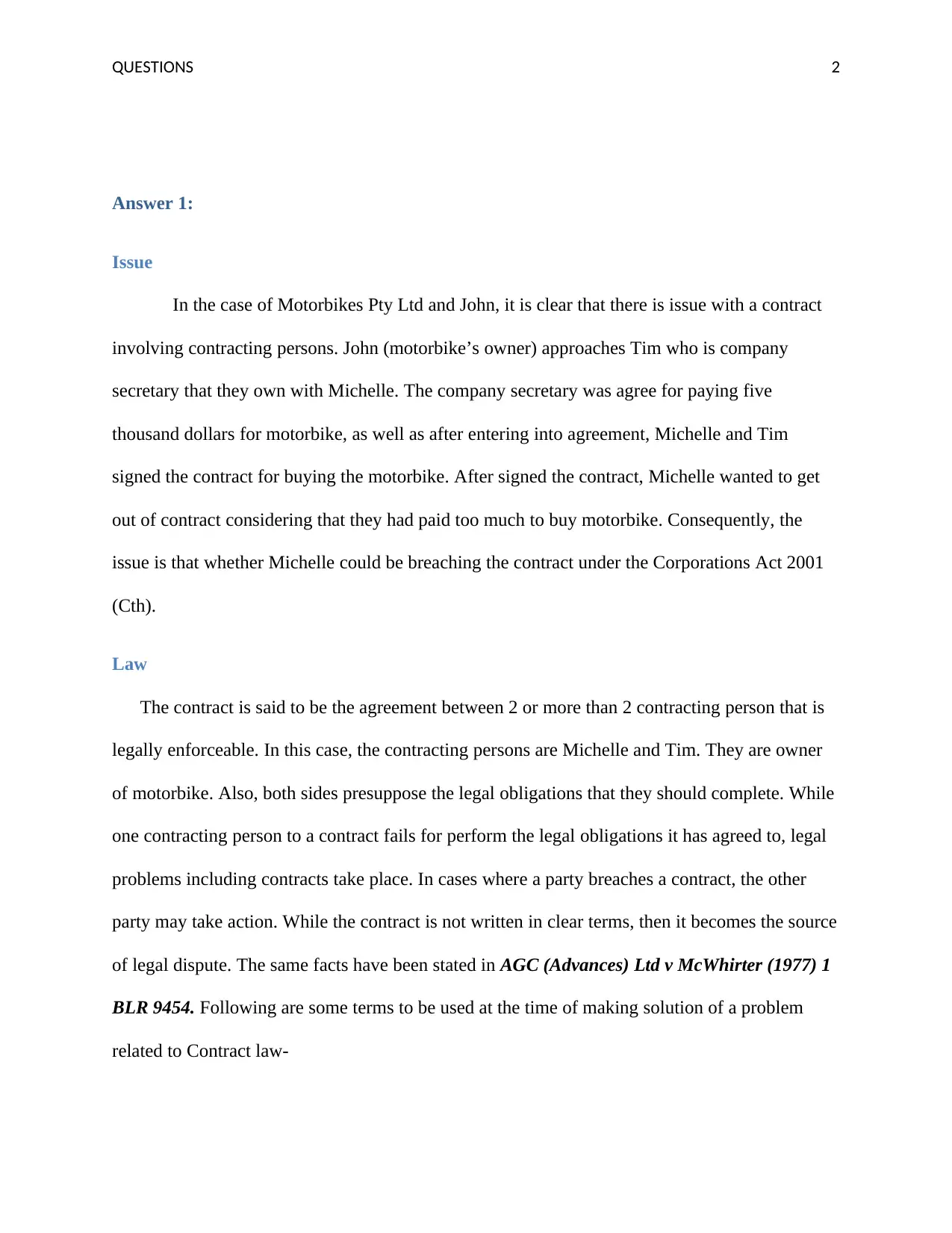
QUESTIONS 2
Answer 1:
Issue
In the case of Motorbikes Pty Ltd and John, it is clear that there is issue with a contract
involving contracting persons. John (motorbike’s owner) approaches Tim who is company
secretary that they own with Michelle. The company secretary was agree for paying five
thousand dollars for motorbike, as well as after entering into agreement, Michelle and Tim
signed the contract for buying the motorbike. After signed the contract, Michelle wanted to get
out of contract considering that they had paid too much to buy motorbike. Consequently, the
issue is that whether Michelle could be breaching the contract under the Corporations Act 2001
(Cth).
Law
The contract is said to be the agreement between 2 or more than 2 contracting person that is
legally enforceable. In this case, the contracting persons are Michelle and Tim. They are owner
of motorbike. Also, both sides presuppose the legal obligations that they should complete. While
one contracting person to a contract fails for perform the legal obligations it has agreed to, legal
problems including contracts take place. In cases where a party breaches a contract, the other
party may take action. While the contract is not written in clear terms, then it becomes the source
of legal dispute. The same facts have been stated in AGC (Advances) Ltd v McWhirter (1977) 1
BLR 9454. Following are some terms to be used at the time of making solution of a problem
related to Contract law-
Answer 1:
Issue
In the case of Motorbikes Pty Ltd and John, it is clear that there is issue with a contract
involving contracting persons. John (motorbike’s owner) approaches Tim who is company
secretary that they own with Michelle. The company secretary was agree for paying five
thousand dollars for motorbike, as well as after entering into agreement, Michelle and Tim
signed the contract for buying the motorbike. After signed the contract, Michelle wanted to get
out of contract considering that they had paid too much to buy motorbike. Consequently, the
issue is that whether Michelle could be breaching the contract under the Corporations Act 2001
(Cth).
Law
The contract is said to be the agreement between 2 or more than 2 contracting person that is
legally enforceable. In this case, the contracting persons are Michelle and Tim. They are owner
of motorbike. Also, both sides presuppose the legal obligations that they should complete. While
one contracting person to a contract fails for perform the legal obligations it has agreed to, legal
problems including contracts take place. In cases where a party breaches a contract, the other
party may take action. While the contract is not written in clear terms, then it becomes the source
of legal dispute. The same facts have been stated in AGC (Advances) Ltd v McWhirter (1977) 1
BLR 9454. Following are some terms to be used at the time of making solution of a problem
related to Contract law-
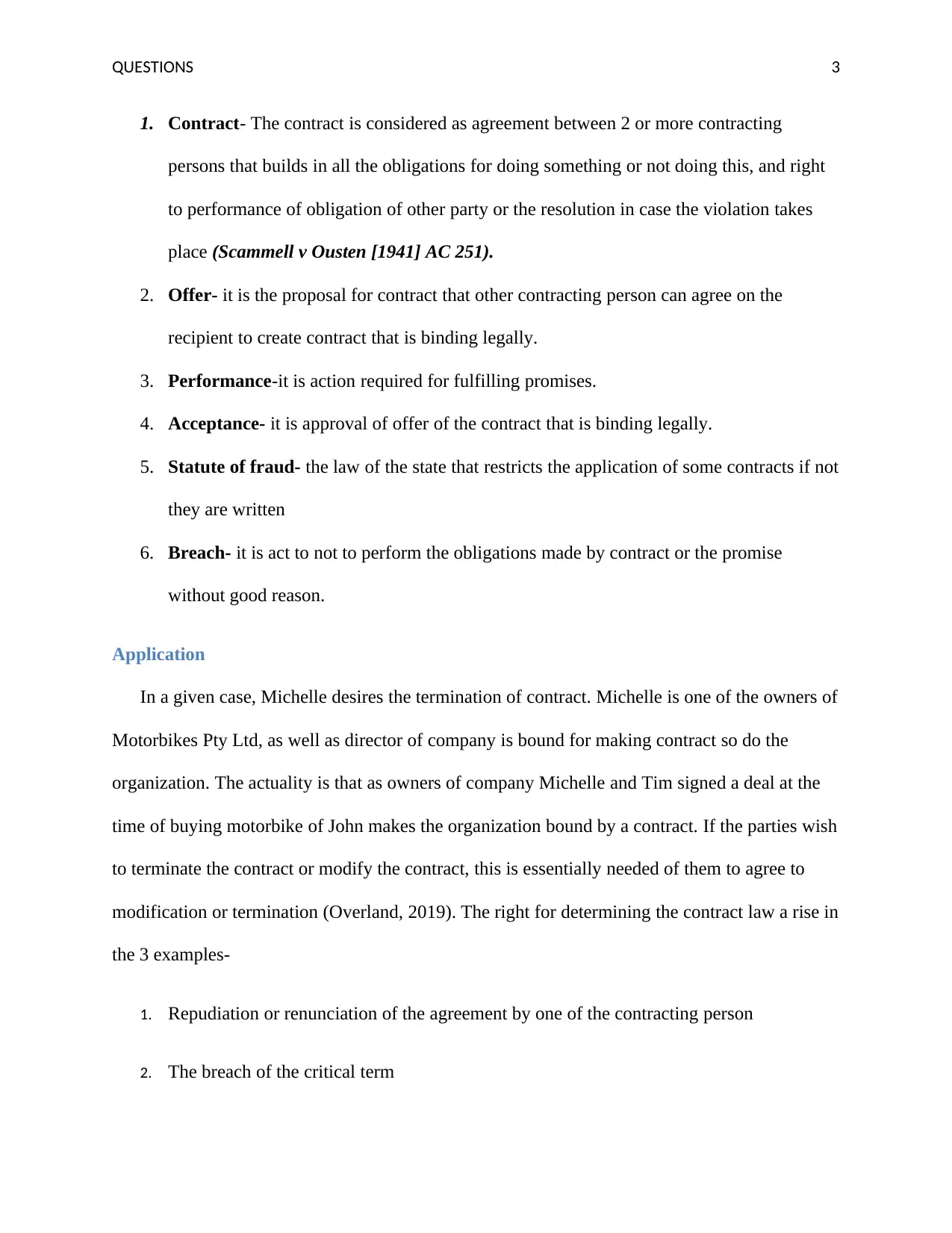
QUESTIONS 3
1. Contract- The contract is considered as agreement between 2 or more contracting
persons that builds in all the obligations for doing something or not doing this, and right
to performance of obligation of other party or the resolution in case the violation takes
place (Scammell v Ousten [1941] AC 251).
2. Offer- it is the proposal for contract that other contracting person can agree on the
recipient to create contract that is binding legally.
3. Performance-it is action required for fulfilling promises.
4. Acceptance- it is approval of offer of the contract that is binding legally.
5. Statute of fraud- the law of the state that restricts the application of some contracts if not
they are written
6. Breach- it is act to not to perform the obligations made by contract or the promise
without good reason.
Application
In a given case, Michelle desires the termination of contract. Michelle is one of the owners of
Motorbikes Pty Ltd, as well as director of company is bound for making contract so do the
organization. The actuality is that as owners of company Michelle and Tim signed a deal at the
time of buying motorbike of John makes the organization bound by a contract. If the parties wish
to terminate the contract or modify the contract, this is essentially needed of them to agree to
modification or termination (Overland, 2019). The right for determining the contract law a rise in
the 3 examples-
1. Repudiation or renunciation of the agreement by one of the contracting person
2. The breach of the critical term
1. Contract- The contract is considered as agreement between 2 or more contracting
persons that builds in all the obligations for doing something or not doing this, and right
to performance of obligation of other party or the resolution in case the violation takes
place (Scammell v Ousten [1941] AC 251).
2. Offer- it is the proposal for contract that other contracting person can agree on the
recipient to create contract that is binding legally.
3. Performance-it is action required for fulfilling promises.
4. Acceptance- it is approval of offer of the contract that is binding legally.
5. Statute of fraud- the law of the state that restricts the application of some contracts if not
they are written
6. Breach- it is act to not to perform the obligations made by contract or the promise
without good reason.
Application
In a given case, Michelle desires the termination of contract. Michelle is one of the owners of
Motorbikes Pty Ltd, as well as director of company is bound for making contract so do the
organization. The actuality is that as owners of company Michelle and Tim signed a deal at the
time of buying motorbike of John makes the organization bound by a contract. If the parties wish
to terminate the contract or modify the contract, this is essentially needed of them to agree to
modification or termination (Overland, 2019). The right for determining the contract law a rise in
the 3 examples-
1. Repudiation or renunciation of the agreement by one of the contracting person
2. The breach of the critical term
⊘ This is a preview!⊘
Do you want full access?
Subscribe today to unlock all pages.

Trusted by 1+ million students worldwide
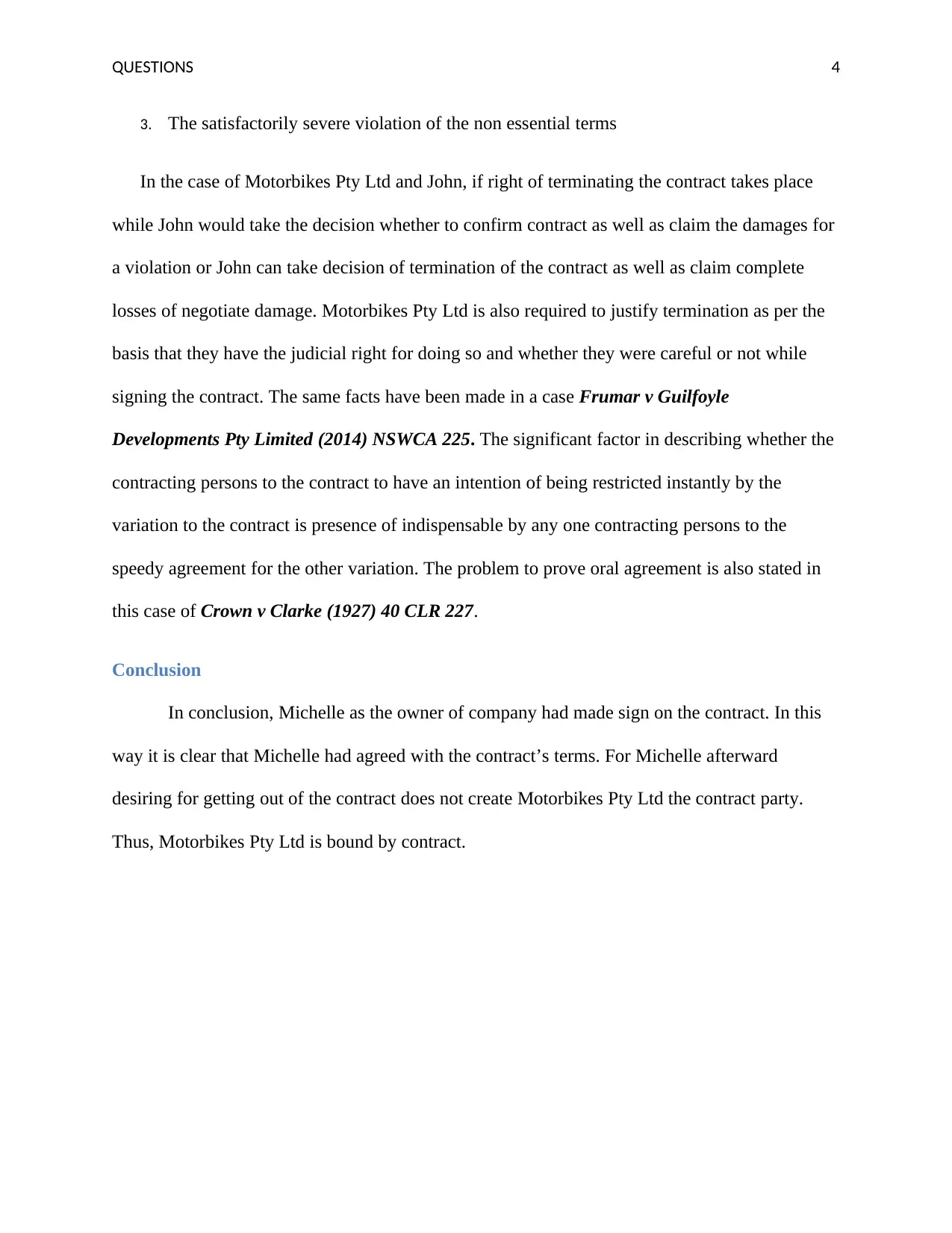
QUESTIONS 4
3. The satisfactorily severe violation of the non essential terms
In the case of Motorbikes Pty Ltd and John, if right of terminating the contract takes place
while John would take the decision whether to confirm contract as well as claim the damages for
a violation or John can take decision of termination of the contract as well as claim complete
losses of negotiate damage. Motorbikes Pty Ltd is also required to justify termination as per the
basis that they have the judicial right for doing so and whether they were careful or not while
signing the contract. The same facts have been made in a case Frumar v Guilfoyle
Developments Pty Limited (2014) NSWCA 225. The significant factor in describing whether the
contracting persons to the contract to have an intention of being restricted instantly by the
variation to the contract is presence of indispensable by any one contracting persons to the
speedy agreement for the other variation. The problem to prove oral agreement is also stated in
this case of Crown v Clarke (1927) 40 CLR 227.
Conclusion
In conclusion, Michelle as the owner of company had made sign on the contract. In this
way it is clear that Michelle had agreed with the contract’s terms. For Michelle afterward
desiring for getting out of the contract does not create Motorbikes Pty Ltd the contract party.
Thus, Motorbikes Pty Ltd is bound by contract.
3. The satisfactorily severe violation of the non essential terms
In the case of Motorbikes Pty Ltd and John, if right of terminating the contract takes place
while John would take the decision whether to confirm contract as well as claim the damages for
a violation or John can take decision of termination of the contract as well as claim complete
losses of negotiate damage. Motorbikes Pty Ltd is also required to justify termination as per the
basis that they have the judicial right for doing so and whether they were careful or not while
signing the contract. The same facts have been made in a case Frumar v Guilfoyle
Developments Pty Limited (2014) NSWCA 225. The significant factor in describing whether the
contracting persons to the contract to have an intention of being restricted instantly by the
variation to the contract is presence of indispensable by any one contracting persons to the
speedy agreement for the other variation. The problem to prove oral agreement is also stated in
this case of Crown v Clarke (1927) 40 CLR 227.
Conclusion
In conclusion, Michelle as the owner of company had made sign on the contract. In this
way it is clear that Michelle had agreed with the contract’s terms. For Michelle afterward
desiring for getting out of the contract does not create Motorbikes Pty Ltd the contract party.
Thus, Motorbikes Pty Ltd is bound by contract.
Paraphrase This Document
Need a fresh take? Get an instant paraphrase of this document with our AI Paraphraser
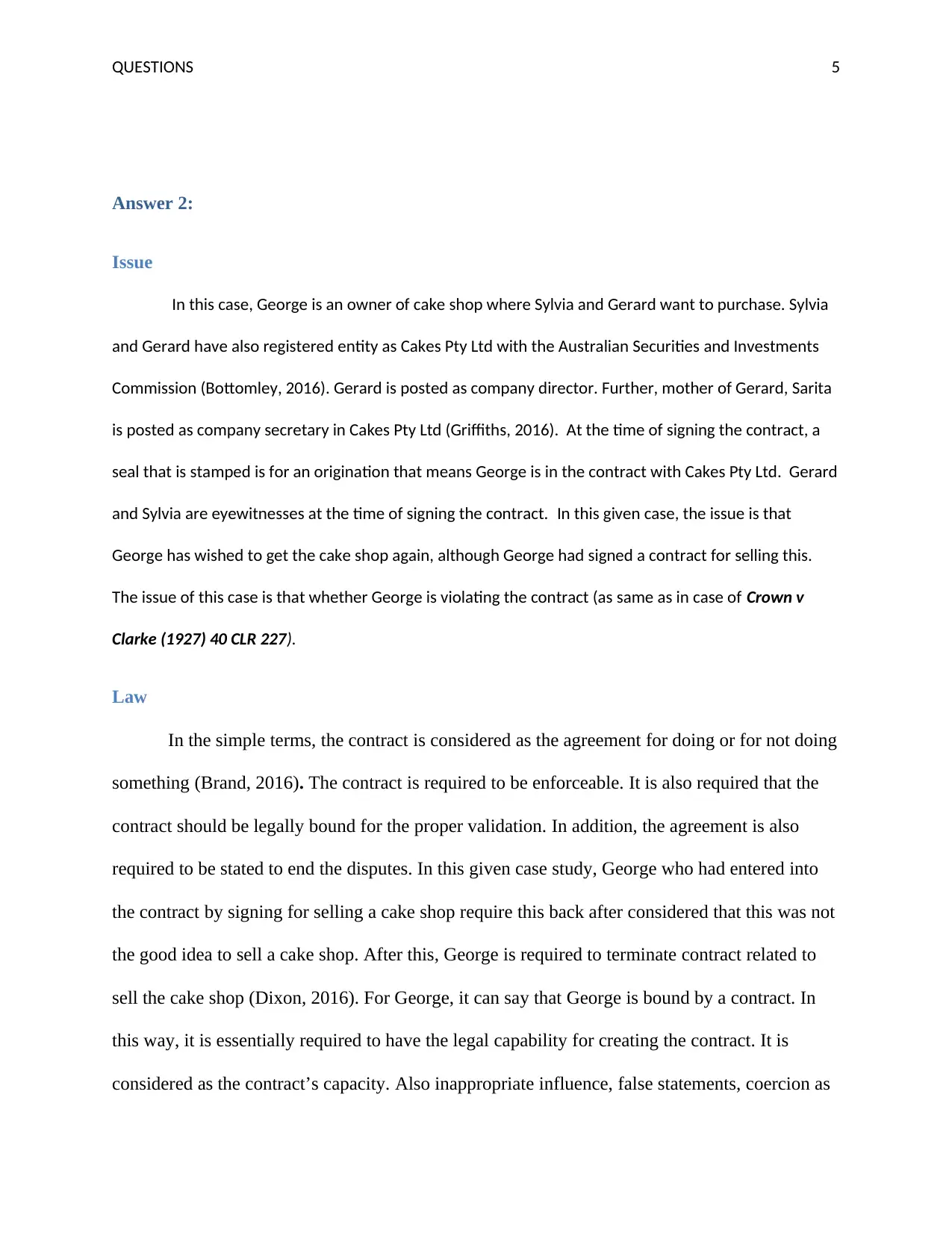
QUESTIONS 5
Answer 2:
Issue
In this case, George is an owner of cake shop where Sylvia and Gerard want to purchase. Sylvia
and Gerard have also registered entity as Cakes Pty Ltd with the Australian Securities and Investments
Commission (Bottomley, 2016). Gerard is posted as company director. Further, mother of Gerard, Sarita
is posted as company secretary in Cakes Pty Ltd (Griffiths, 2016). At the time of signing the contract, a
seal that is stamped is for an origination that means George is in the contract with Cakes Pty Ltd. Gerard
and Sylvia are eyewitnesses at the time of signing the contract. In this given case, the issue is that
George has wished to get the cake shop again, although George had signed a contract for selling this.
The issue of this case is that whether George is violating the contract (as same as in case of Crown v
Clarke (1927) 40 CLR 227).
Law
In the simple terms, the contract is considered as the agreement for doing or for not doing
something (Brand, 2016). The contract is required to be enforceable. It is also required that the
contract should be legally bound for the proper validation. In addition, the agreement is also
required to be stated to end the disputes. In this given case study, George who had entered into
the contract by signing for selling a cake shop require this back after considered that this was not
the good idea to sell a cake shop. After this, George is required to terminate contract related to
sell the cake shop (Dixon, 2016). For George, it can say that George is bound by a contract. In
this way, it is essentially required to have the legal capability for creating the contract. It is
considered as the contract’s capacity. Also inappropriate influence, false statements, coercion as
Answer 2:
Issue
In this case, George is an owner of cake shop where Sylvia and Gerard want to purchase. Sylvia
and Gerard have also registered entity as Cakes Pty Ltd with the Australian Securities and Investments
Commission (Bottomley, 2016). Gerard is posted as company director. Further, mother of Gerard, Sarita
is posted as company secretary in Cakes Pty Ltd (Griffiths, 2016). At the time of signing the contract, a
seal that is stamped is for an origination that means George is in the contract with Cakes Pty Ltd. Gerard
and Sylvia are eyewitnesses at the time of signing the contract. In this given case, the issue is that
George has wished to get the cake shop again, although George had signed a contract for selling this.
The issue of this case is that whether George is violating the contract (as same as in case of Crown v
Clarke (1927) 40 CLR 227).
Law
In the simple terms, the contract is considered as the agreement for doing or for not doing
something (Brand, 2016). The contract is required to be enforceable. It is also required that the
contract should be legally bound for the proper validation. In addition, the agreement is also
required to be stated to end the disputes. In this given case study, George who had entered into
the contract by signing for selling a cake shop require this back after considered that this was not
the good idea to sell a cake shop. After this, George is required to terminate contract related to
sell the cake shop (Dixon, 2016). For George, it can say that George is bound by a contract. In
this way, it is essentially required to have the legal capability for creating the contract. It is
considered as the contract’s capacity. Also inappropriate influence, false statements, coercion as
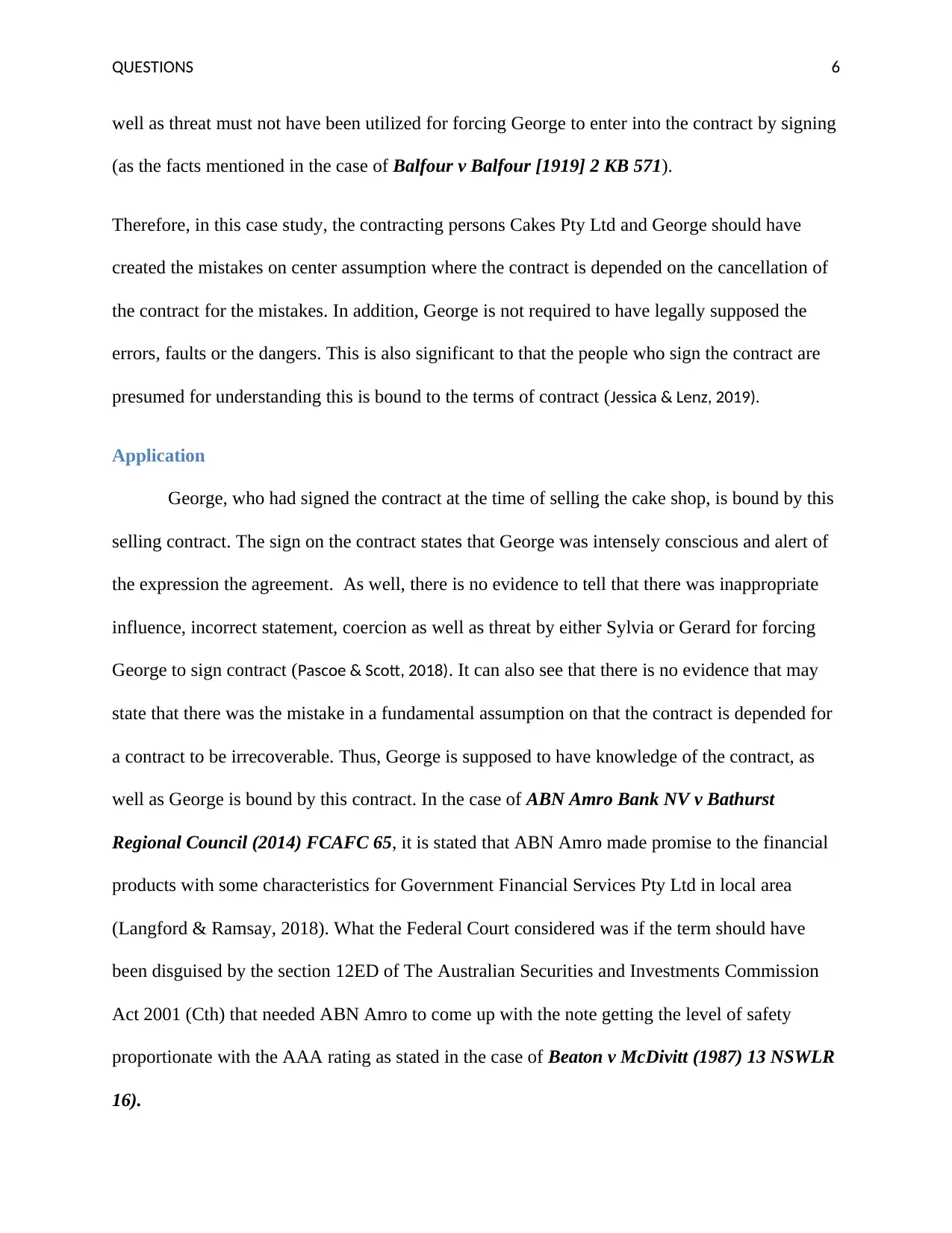
QUESTIONS 6
well as threat must not have been utilized for forcing George to enter into the contract by signing
(as the facts mentioned in the case of Balfour v Balfour [1919] 2 KB 571).
Therefore, in this case study, the contracting persons Cakes Pty Ltd and George should have
created the mistakes on center assumption where the contract is depended on the cancellation of
the contract for the mistakes. In addition, George is not required to have legally supposed the
errors, faults or the dangers. This is also significant to that the people who sign the contract are
presumed for understanding this is bound to the terms of contract (Jessica & Lenz, 2019).
Application
George, who had signed the contract at the time of selling the cake shop, is bound by this
selling contract. The sign on the contract states that George was intensely conscious and alert of
the expression the agreement. As well, there is no evidence to tell that there was inappropriate
influence, incorrect statement, coercion as well as threat by either Sylvia or Gerard for forcing
George to sign contract (Pascoe & Scott, 2018). It can also see that there is no evidence that may
state that there was the mistake in a fundamental assumption on that the contract is depended for
a contract to be irrecoverable. Thus, George is supposed to have knowledge of the contract, as
well as George is bound by this contract. In the case of ABN Amro Bank NV v Bathurst
Regional Council (2014) FCAFC 65, it is stated that ABN Amro made promise to the financial
products with some characteristics for Government Financial Services Pty Ltd in local area
(Langford & Ramsay, 2018). What the Federal Court considered was if the term should have
been disguised by the section 12ED of The Australian Securities and Investments Commission
Act 2001 (Cth) that needed ABN Amro to come up with the note getting the level of safety
proportionate with the AAA rating as stated in the case of Beaton v McDivitt (1987) 13 NSWLR
16).
well as threat must not have been utilized for forcing George to enter into the contract by signing
(as the facts mentioned in the case of Balfour v Balfour [1919] 2 KB 571).
Therefore, in this case study, the contracting persons Cakes Pty Ltd and George should have
created the mistakes on center assumption where the contract is depended on the cancellation of
the contract for the mistakes. In addition, George is not required to have legally supposed the
errors, faults or the dangers. This is also significant to that the people who sign the contract are
presumed for understanding this is bound to the terms of contract (Jessica & Lenz, 2019).
Application
George, who had signed the contract at the time of selling the cake shop, is bound by this
selling contract. The sign on the contract states that George was intensely conscious and alert of
the expression the agreement. As well, there is no evidence to tell that there was inappropriate
influence, incorrect statement, coercion as well as threat by either Sylvia or Gerard for forcing
George to sign contract (Pascoe & Scott, 2018). It can also see that there is no evidence that may
state that there was the mistake in a fundamental assumption on that the contract is depended for
a contract to be irrecoverable. Thus, George is supposed to have knowledge of the contract, as
well as George is bound by this contract. In the case of ABN Amro Bank NV v Bathurst
Regional Council (2014) FCAFC 65, it is stated that ABN Amro made promise to the financial
products with some characteristics for Government Financial Services Pty Ltd in local area
(Langford & Ramsay, 2018). What the Federal Court considered was if the term should have
been disguised by the section 12ED of The Australian Securities and Investments Commission
Act 2001 (Cth) that needed ABN Amro to come up with the note getting the level of safety
proportionate with the AAA rating as stated in the case of Beaton v McDivitt (1987) 13 NSWLR
16).
⊘ This is a preview!⊘
Do you want full access?
Subscribe today to unlock all pages.

Trusted by 1+ million students worldwide
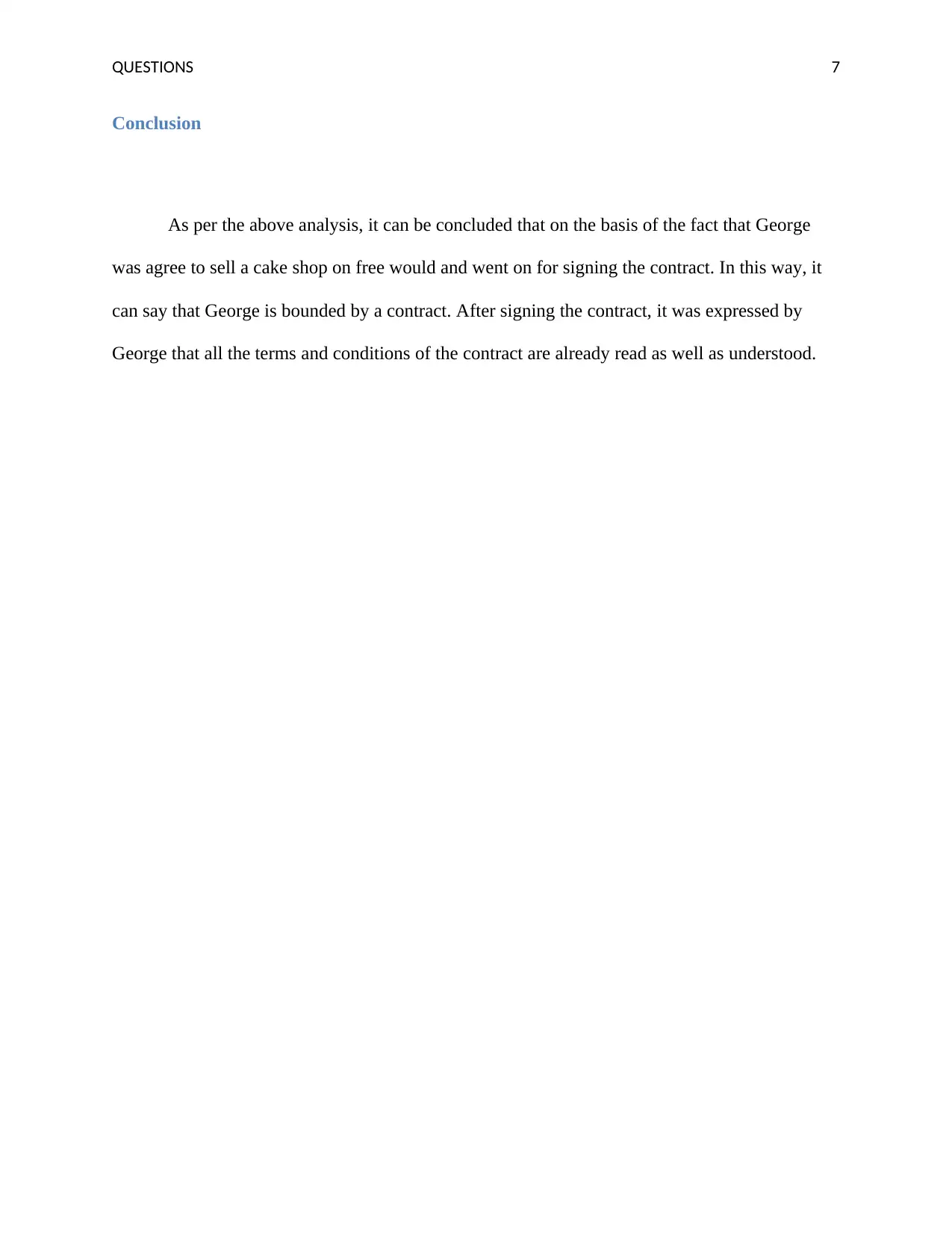
QUESTIONS 7
Conclusion
As per the above analysis, it can be concluded that on the basis of the fact that George
was agree to sell a cake shop on free would and went on for signing the contract. In this way, it
can say that George is bounded by a contract. After signing the contract, it was expressed by
George that all the terms and conditions of the contract are already read as well as understood.
Conclusion
As per the above analysis, it can be concluded that on the basis of the fact that George
was agree to sell a cake shop on free would and went on for signing the contract. In this way, it
can say that George is bounded by a contract. After signing the contract, it was expressed by
George that all the terms and conditions of the contract are already read as well as understood.
Paraphrase This Document
Need a fresh take? Get an instant paraphrase of this document with our AI Paraphraser
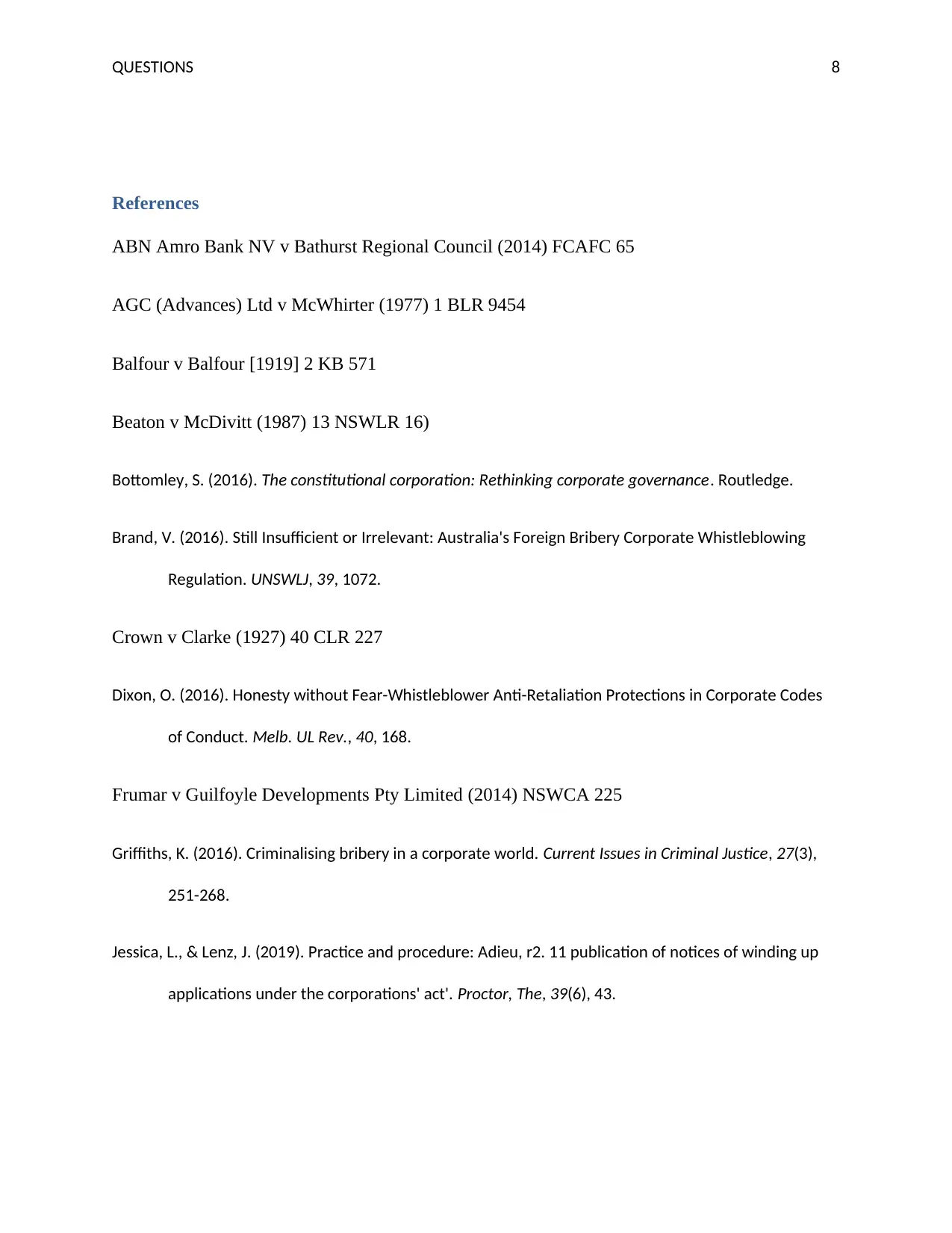
QUESTIONS 8
References
ABN Amro Bank NV v Bathurst Regional Council (2014) FCAFC 65
AGC (Advances) Ltd v McWhirter (1977) 1 BLR 9454
Balfour v Balfour [1919] 2 KB 571
Beaton v McDivitt (1987) 13 NSWLR 16)
Bottomley, S. (2016). The constitutional corporation: Rethinking corporate governance. Routledge.
Brand, V. (2016). Still Insufficient or Irrelevant: Australia's Foreign Bribery Corporate Whistleblowing
Regulation. UNSWLJ, 39, 1072.
Crown v Clarke (1927) 40 CLR 227
Dixon, O. (2016). Honesty without Fear-Whistleblower Anti-Retaliation Protections in Corporate Codes
of Conduct. Melb. UL Rev., 40, 168.
Frumar v Guilfoyle Developments Pty Limited (2014) NSWCA 225
Griffiths, K. (2016). Criminalising bribery in a corporate world. Current Issues in Criminal Justice, 27(3),
251-268.
Jessica, L., & Lenz, J. (2019). Practice and procedure: Adieu, r2. 11 publication of notices of winding up
applications under the corporations' act'. Proctor, The, 39(6), 43.
References
ABN Amro Bank NV v Bathurst Regional Council (2014) FCAFC 65
AGC (Advances) Ltd v McWhirter (1977) 1 BLR 9454
Balfour v Balfour [1919] 2 KB 571
Beaton v McDivitt (1987) 13 NSWLR 16)
Bottomley, S. (2016). The constitutional corporation: Rethinking corporate governance. Routledge.
Brand, V. (2016). Still Insufficient or Irrelevant: Australia's Foreign Bribery Corporate Whistleblowing
Regulation. UNSWLJ, 39, 1072.
Crown v Clarke (1927) 40 CLR 227
Dixon, O. (2016). Honesty without Fear-Whistleblower Anti-Retaliation Protections in Corporate Codes
of Conduct. Melb. UL Rev., 40, 168.
Frumar v Guilfoyle Developments Pty Limited (2014) NSWCA 225
Griffiths, K. (2016). Criminalising bribery in a corporate world. Current Issues in Criminal Justice, 27(3),
251-268.
Jessica, L., & Lenz, J. (2019). Practice and procedure: Adieu, r2. 11 publication of notices of winding up
applications under the corporations' act'. Proctor, The, 39(6), 43.
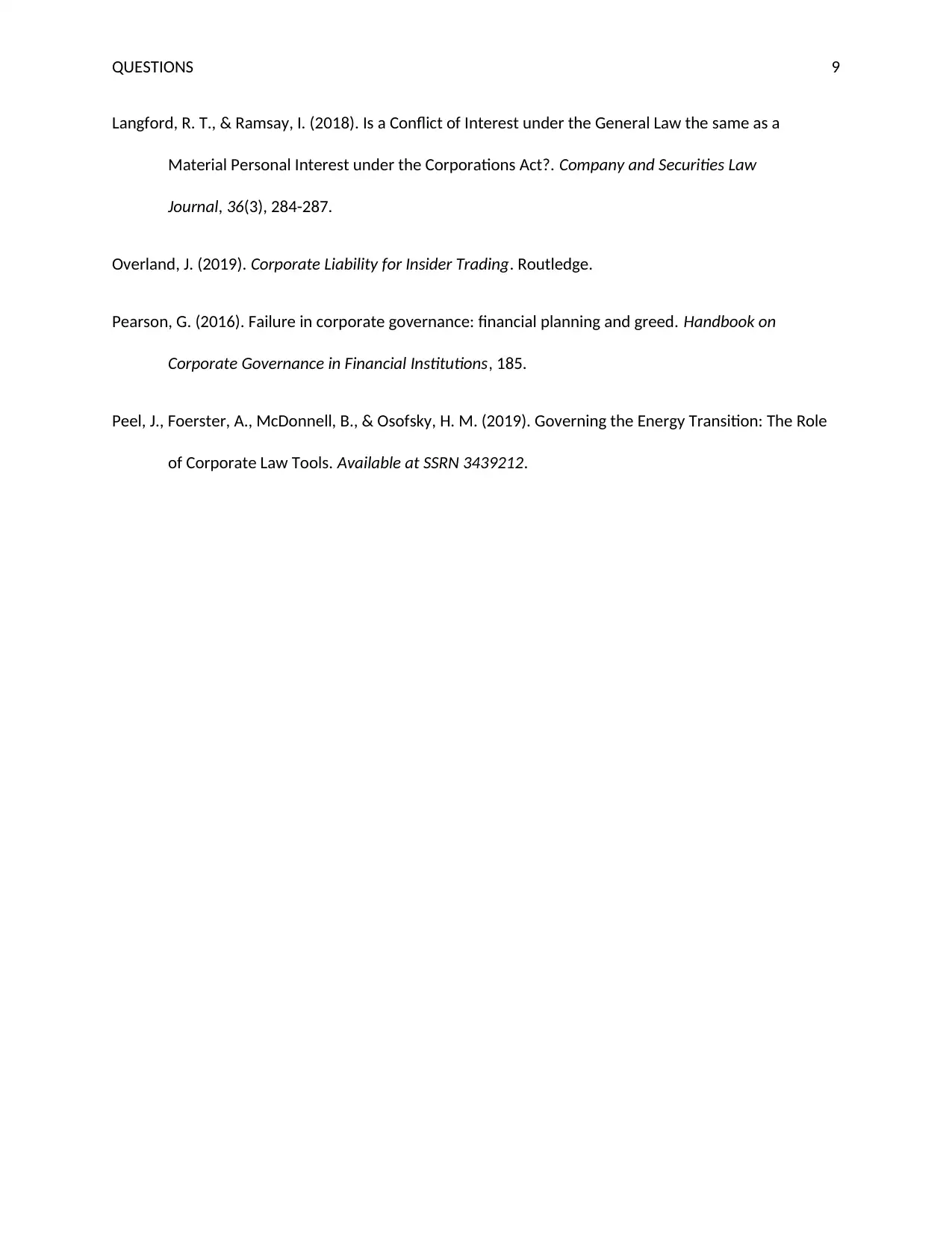
QUESTIONS 9
Langford, R. T., & Ramsay, I. (2018). Is a Conflict of Interest under the General Law the same as a
Material Personal Interest under the Corporations Act?. Company and Securities Law
Journal, 36(3), 284-287.
Overland, J. (2019). Corporate Liability for Insider Trading. Routledge.
Pearson, G. (2016). Failure in corporate governance: financial planning and greed. Handbook on
Corporate Governance in Financial Institutions, 185.
Peel, J., Foerster, A., McDonnell, B., & Osofsky, H. M. (2019). Governing the Energy Transition: The Role
of Corporate Law Tools. Available at SSRN 3439212.
Langford, R. T., & Ramsay, I. (2018). Is a Conflict of Interest under the General Law the same as a
Material Personal Interest under the Corporations Act?. Company and Securities Law
Journal, 36(3), 284-287.
Overland, J. (2019). Corporate Liability for Insider Trading. Routledge.
Pearson, G. (2016). Failure in corporate governance: financial planning and greed. Handbook on
Corporate Governance in Financial Institutions, 185.
Peel, J., Foerster, A., McDonnell, B., & Osofsky, H. M. (2019). Governing the Energy Transition: The Role
of Corporate Law Tools. Available at SSRN 3439212.
⊘ This is a preview!⊘
Do you want full access?
Subscribe today to unlock all pages.

Trusted by 1+ million students worldwide
1 out of 9
Related Documents
Your All-in-One AI-Powered Toolkit for Academic Success.
+13062052269
info@desklib.com
Available 24*7 on WhatsApp / Email
![[object Object]](/_next/static/media/star-bottom.7253800d.svg)
Unlock your academic potential
Copyright © 2020–2025 A2Z Services. All Rights Reserved. Developed and managed by ZUCOL.





